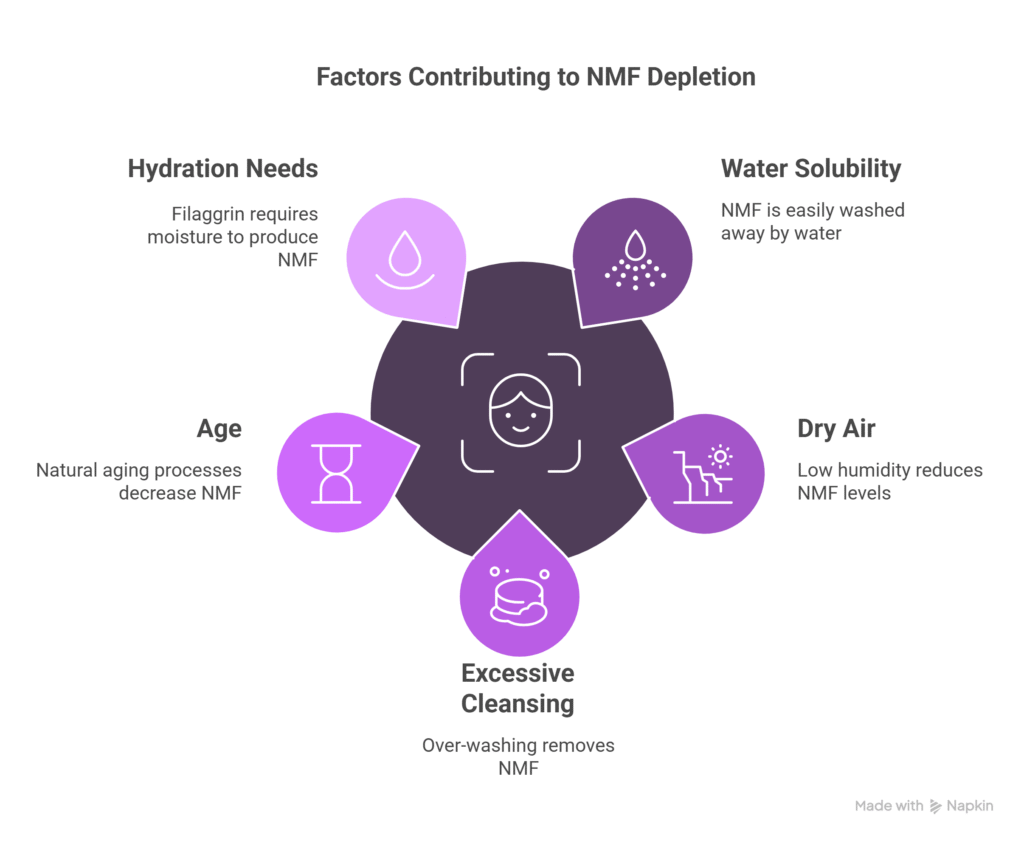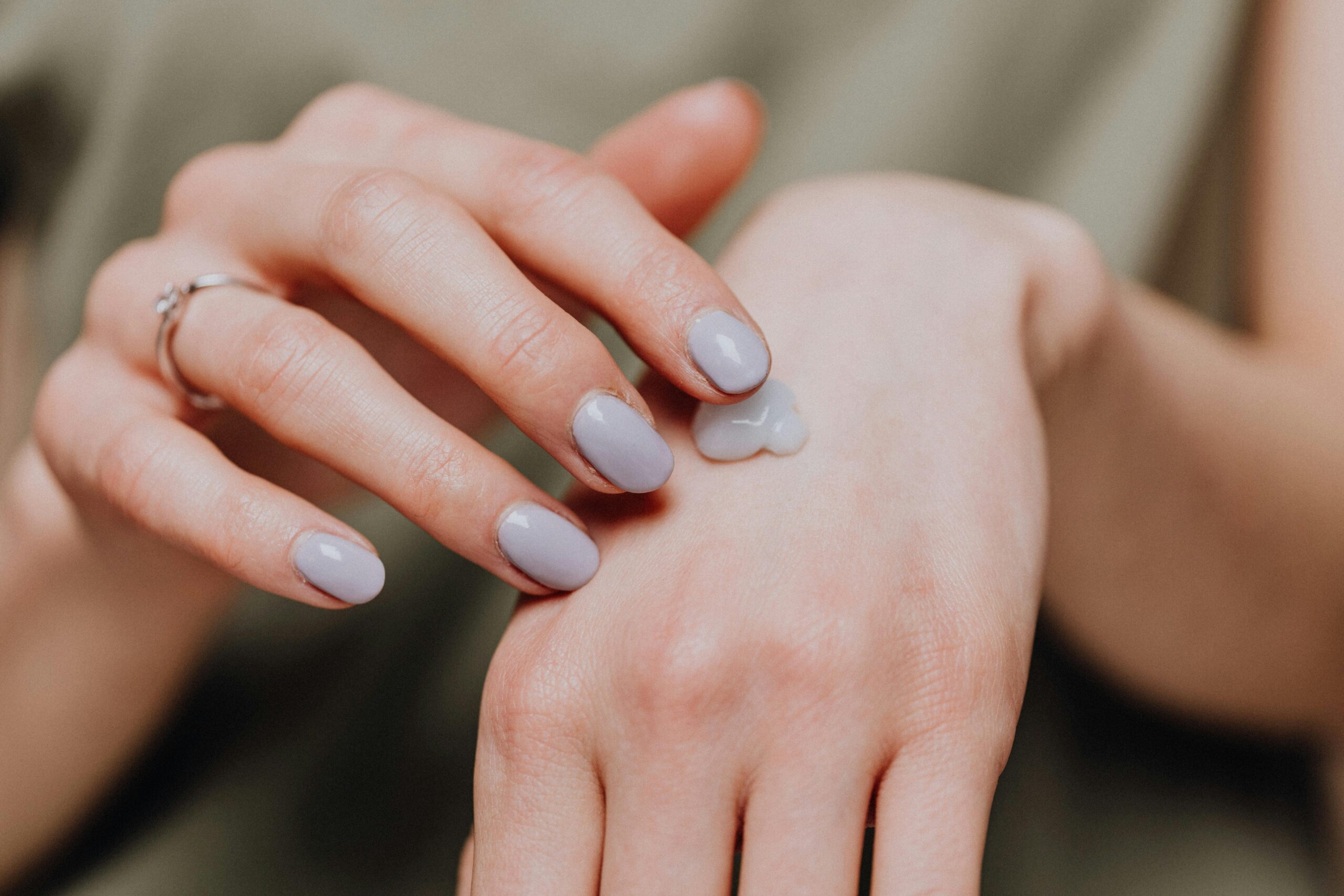When Moisturizer Doesn’t Work (and Why It’s Not Your Fault)
Ever applied your go-to cream, only to end up with dry skin after moisturizing—tight, flaky, and just as dehydrated as before?
You’re not alone—and you’re not imagining it. Contrary to what many product labels promise, hydration isn’t just about applying a thick cream. In fact, moisturizers can sometimes trap dryness in rather than moisture, especially if your skin’s internal hydration systems are already out of sync.
In this article, we dive deep into the real reasons your skin still feels dry after moisturizing.
We’ll explore three overlooked, science-backed factors:
- TEWL (Transepidermal Water Loss)
- NMF (Natural Moisturizing Factor)
- The skin’s moisture gradient

Spoiler alert: it’s not always the product’s fault—it’s often a mismatch between what the skin biologically needs and what most moisturizers deliver.
- When Moisturizer Doesn’t Work (and Why It’s Not Your Fault)
- Why You Still Have Dry Skin After Moisturizing And What Your Cream Might Be Missing
- TEWL — The Force Behind Persistent Dryness
- NMF — The Hydration System Inside Your Skin
- The Moisture Gradient — Hydration’s Highway
- Why Occlusion Alone Isn’t the Answer
- Building a Routine That Actually Rehydrates
Why You Still Have Dry Skin After Moisturizing And What Your Cream Might Be Missing
A well-formulated moisturizer should do three things:
- Attract water to the outer layers of skin
- Seal in that water to prevent evaporation
- Support the skin’s own repair mechanisms by replenishing key components like lipids and NMF

But many moisturizers don’t deliver all three—and that’s where problems begin.
Moisturizer Ingredients and What They Really Do
| Ingredient Type | Function | Common Examples | Limitation |
| Humectants | Attract moisture into skin | Glycerin, Urea, Sodium PCA | Need water to work, ineffective in dry air |
| Emollients | Soften and smooth the skin | Fatty alcohols, squalane | Don’t address hydration loss |
| Occlusives | Prevent water from evaporating | Petrolatum, silicones | Seal in moisture—but don’t add any |

Key Insight: If your skin is already dehydrated, a heavy cream might just seal in the dryness.
What’s Often Missing
Even products labeled for “intense hydration” may skip vital elements:
- No humectants to pull water in
- No NMF-mimicking ingredients like urea or lactic acid
- No barrier lipids in the right ratios (ceramides, cholesterol, fatty acids)
Fact Check: According to Harry’s Cosmeticology, petrolatum (Vaseline) can block up to 99% of TEWL. But if your skin lacks internal hydration, there’s nothing left to retain.
Real-Life Result
That creamy balm might feel soothing at first, but without restoring lost water or NMF, hydration fades—and dry skin after moisturizing comes right back.

Pro Tip: Apply moisturizer to slightly damp skin, especially if using humectants. This provides the extra water these ingredients need to function.
TEWL — The Force Behind Persistent Dryness
What Is TEWL?
TEWL stands for transepidermal water loss—the natural process of water escaping through the skin barrier. It’s normal, but when the skin is compromised, TEWL spikes, and dryness becomes a visible problem.
According to Voegeli (2008):
- TEWL increases even with water-only washing
- Towel drying amplifies the loss
- Without replenishment, skin can take over 90 minutes to begin recovery
Layman’s translation: Your skin is leaking water—and if you don’t support it, it can’t catch up.
When Environment Works Against You
Egawa et al. (2002) showed that TEWL increases sharply in low humidity (10% RH):
- Skin becomes visibly flaky
- Corneocytes shrink, weakening cohesion
- Moisturizers that don’t seal or replenish water offer limited benefit

Even the best moisturizer struggles without supportive environmental conditions.
How TEWL Works in Real Skin
| Situation | TEWL Behavior | Result |
| Water-only face washing | ↑ Moderate | Surface hydration lost |
| Harsh soap or hot water | ↑↑ High | Lipids and proteins damaged |
| No moisturizer afterward | ↑↑↑ Very High | NMF loss + delayed recovery |
| Moisturizer with lipids + humectants | ↓ Lowers TEWL | Repairs and rehydrates |
NMF — The Hydration System Inside Your Skin
What is NMF?
The Natural Moisturizing Factor (NMF) is your skin’s built-in hydration system. It’s made of water-binding molecules located inside corneocytes—the cells of the stratum corneum (skin surface).
NMF includes:
- Amino acids from filaggrin breakdown
- Urea
- Lactic acid
- Sodium PCA
- Minerals like magnesium and calcium
Scientific Insight (Rawlings & Harding, 2004): NMF makes up as much as 30% of the stratum corneum’s dry weight.
How NMF Gets Depleted
- It’s water-soluble—so even water-only washing can rinse it away (Voegeli, 2008)
- Dry air, excessive cleansing, and age reduce NMF levels
- Filaggrin—the precursor to NMF—requires a hydrated environment to break down properly (Verdier-Sévrain, 2007)
Without hydration, your skin makes less of the very molecules that hold water. It’s a biological catch-22.

Why Most Moisturizers Don’t Replace It
Even thick creams often miss NMF altogether. Unless they include:
- Urea
- Pyrrolidone carboxylic acid (PCA)
- Amino acids
they won’t actually rebuild your skin’s internal water-binding network.
| Moisturizer Type | Replaces NMF? | Long-Term Hydration? |
| Petrolatum-based ointment | ❌ | Superficial, short-lived |
| Hyaluronic acid serum | ❌ | Evaporates in dry air |
| Cream with urea + PCA | ✅ | Restores hydration capacity |

Pro Tip: NMF isn’t optional. Without it, your skin may stay dry no matter how rich your moisturizer feels.
The Moisture Gradient — Hydration’s Highway
Let’s talk gradients—specifically, the skin’s internal moisture gradient. If your moisturizer isn’t working, this subtle but critical system might be out of balance.
What is the Moisture Gradient?
Think of your skin as a layered sponge. Deep in the epidermis, water concentration is high. Near the surface—the stratum corneum—it’s much lower. This creates a moisture gradient, a natural diffusion process that pulls water upward. It’s what keeps your outer skin layers supple and enzymatically active.
When this gradient flattens, even the best moisturizer may not make a difference. Instead of drawing water upward, the skin:
- Stops transporting internal moisture to the surface
- Allows more water to evaporate through TEWL
- Becomes less responsive to enzymes that maintain healthy turnover
Scientific Insight
Verdier-Sévrain & Bonté (2007) emphasize that a functioning moisture gradient is essential for:
- Filaggrin breakdown into NMF components
- Enzymatic desquamation (the natural shedding of dead skin cells)
- Skin softness and flexibility
In dry environments or after barrier disruption, this gradient collapses. Water can no longer move efficiently through the skin, making topically applied hydration less effective.
Analogy: Think of your skin like a house with faulty plumbing. Even if you pour water on the roof (moisturizer), the inside stays dry unless the pipes (moisture channels) are fixed.
Table: How Moisture Gradient Affects Skin Health
| Gradient Status | Skin Behavior | Hydration Impact |
| Steep (healthy) | Water flows upward naturally | Enzymes active, hydration intact |
| Flattened (damaged) | Water movement slows or halts | NMF declines, dryness increases |
| Occlusion-only (no water) | TEWL blocked, but no internal replenishment | Surface may feel greasy, not hydrated |
Everyday Example: Skin may feel plump in a humid city like Singapore but tight and flaky in a cold, dry climate like Denver—even with the same product. The difference? Environmental support of the moisture gradient.
Why Occlusion Alone Isn’t the Answer
Occlusives like petrolatum and silicones are skincare staples. They form a protective film that physically blocks water from escaping. But here’s where it gets complicated: occlusion doesn’t add moisture—it only preserves what’s already there.
What Occlusives Actually Do
- Reduce TEWL by up to 99%
- Improve barrier function temporarily, especially in acute dryness
- Create a smooth, sealed surface that may enhance product absorption
But occlusives don’t:
- Increase skin’s internal water levels
- Replenish NMF or lipids
- Reactivate enzyme processes in dehydrated skin

You can’t seal in what isn’t there. Occlusion should be the final step in a hydration-first routine—not a standalone fix.
When Occlusion Works Against You
- In low humidity, occlusives block external moisture from entering and trap a dry state inside
- Without humectants, occlusives may leave skin feeling occluded but still thirsty
- Without lipids and ceramides, the surface seal doesn’t restore the skin’s internal repair capacity
Table: Occlusion—Effective or Incomplete?
| Routine Type | Result | Recommendation |
| Occlusive only | Surface sealed, hydration unchanged | Add humectants + barrier lipids |
| Humectant + occlusive | Water drawn in, then sealed | Best in humid or post-cleansing settings |
| Lipid + occlusive | Restores barrier, but may lack hydration | Combine with water-binding layer |
Pro Tip: In winter, occlusion helps reduce windburn and barrier disruption, but without a humectant layer underneath, your skin may still feel rough or flaky.

Slathering petroleum jelly on cracked heels without soaking or hydrating first may create a greasy film—but the dryness underneath remains.
Building a Routine That Actually Rehydrates
So how do you make sure your skin not only feels moisturized—but is moisturized at a biological level? Follow the logic of skin science.
Step 1: Cleanse Smart
- Use low-pH cleansers (4.5–5.5) to preserve the acid mantle
- Avoid high-foaming surfactants or alkaline soaps
- Pat skin dry—don’t rub. Voegeli (2008) showed that rubbing significantly raises TEWL compared to gentle drying
Example: Choose a cream cleanser over a foaming gel if your skin feels tight post-wash—this small switch can reduce moisture loss significantly.
Step 2: Add Hydration First
- Apply a water-based hydrating layer—this can be a mist, essence, or serum
- Look for humectants like glycerin, urea, sodium PCA, and hyaluronic acid
These ingredients bind water into the stratum corneum, kickstarting the moisture gradient from within. They also support NMF production, assuming the skin has enough internal water to begin with.
Fun Fact: Urea isn’t just a humectant—it’s also mildly keratolytic, helping enzymes break down dead skin more effectively.
Step 3: Rebuild the Barrier
Now that hydration is present, seal it with a moisturizer rich in:
- Ceramides (especially NP, EOP, AP)
- Cholesterol
- Fatty acids (ideally linoleic acid)
According to Rawlings & Harding (2004), a 3:1:1 ratio of ceramides:cholesterol:fatty acids mimics the skin’s own lipid matrix and accelerates recovery after barrier stress.
Example: After a cold-weather hike, apply a ceramide-rich cream or a formulation with phytosphingosine and cholesterol to actively rebuild your barrier—not just soothe it.
Step 4: Occlude Strategically (Optional)
In harsh environments or for overnight routines:
- Use squalane, petrolatum, or shea butter to reinforce the surface seal
- Apply sparingly, especially if layering over serums and actives
Important: Always layer occlusives last, after hydration and barrier support. Otherwise, you risk blocking in dehydration.
Full Routine Recap
| Step | Purpose | Example Ingredients |
| Cleanse | Preserve NMF and pH | Non-foaming, pH 4.5–5.5 |
| Hydrate | Attract and bind water | Glycerin, urea, amino acids |
| Moisturize | Replenish barrier lipids + NMF | Ceramides, PCA, fatty acids |
| Occlude | Prevent water loss | Petrolatum, squalane, lanolin |
Key Takeaway: Skincare isn’t just about what’s in the bottle—it’s about when and how you apply it, and whether it complements your skin’s biology.
Fixing dry skin after moisturizing isn’t about using more product—it’s about supporting the skin’s biology with what it actually needs.
Still wondering why your skin feels dry even after moisturizing? You now know that:
- TEWL can persist if moisture isn’t replaced internally
- NMF loss and a flattened moisture gradient sabotage surface-level fixes
- Occlusion without hydration is like closing a lid on an empty jar
When you understand skin biology, your routine shifts from reactive to restorative. It becomes less about fighting symptoms—and more about supporting systems.
Talk to you soon!
Dr Bozica
References:
https://onlinelibrary.wiley.com/doi/full/10.1034/j.1600-0846.2002.00351.x
https://www.tandfonline.com/doi/full/10.2147/CCID.S86822?scroll=top&needAccess=true
https://onlinelibrary.wiley.com/doi/full/10.1111/j.1473-2165.2007.00300.x
https://onlinelibrary.wiley.com/doi/full/10.1111/j.1396-0296.2004.04S1005.x

